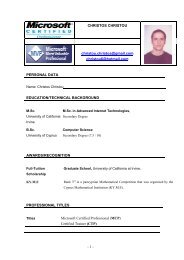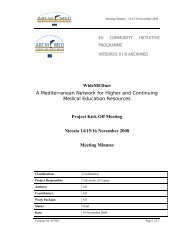Routing Protocols for Ad Hoc Mobile Wireless Networks
Routing Protocols for Ad Hoc Mobile Wireless Networks
Routing Protocols for Ad Hoc Mobile Wireless Networks
You also want an ePaper? Increase the reach of your titles
YUMPU automatically turns print PDFs into web optimized ePapers that Google loves.
<strong>Routing</strong> <strong>Protocols</strong> <strong>for</strong> <strong>Ad</strong> <strong>Hoc</strong> <strong>Mobile</strong> <strong>Wireless</strong> <strong>Networks</strong><br />
2.6 Zone-based Hierarchical Link State <strong>Routing</strong><br />
Protocol<br />
In Zone-based Hierarchical Link State <strong>Routing</strong> Protocol (ZHLS)[Joa-Ng99], the network is divided into<br />
non-overlapping zones. Unlike other hierarchical protocols, there is no zone-head. ZHLS defines two<br />
levels of topologies - node level and zone level. A node level topology tells how nodes of a zone are<br />
connected to each other physically. A virtual link between two zones exists if at least one node of a zone<br />
is physically connected to some node of the other zone. Zone level topology tells how zones are<br />
connected together. There are two types of Link State Packets (LSP) as well - node LSP and zone LSP. A<br />
node LSP of a node contains its neighbor node in<strong>for</strong>mation and is propagated with the zone where as a<br />
zone LSP contains the zone in<strong>for</strong>mation and is propagated globally. So each node has full node<br />
connectivity knowledge about the nodes in its zone and only zone connectivity in<strong>for</strong>mation about other<br />
zones in the network. So given the zone id and the node id of a destination, the packet is routed based on<br />
the zone id till it reaches the correct zone. Then in that zone, it is routed based on node id. A of the destination is sufficient <strong>for</strong> routing so it is adaptable to changing topologies.<br />
2.7 Clusterhead Gateway Switch <strong>Routing</strong> Protocol<br />
Clusterhead Gateway Switch <strong>Routing</strong> (CGSR) [Chiang97] uses as basis the DSDV <strong>Routing</strong> algorithm<br />
described in the previous section.<br />
The mobile nodes are aggregated into clusters and a cluster-head is elected. All nodes that are in the<br />
communication range of the cluster-head belong to its cluster. A gateway node is a node that is in the<br />
communication range of two or more cluster-heads. In a dynamic network cluster head scheme can cause<br />
per<strong>for</strong>mance degradation due to frequent cluster-head elections, so CGSR uses a Least Cluster Change<br />
(LCC) algorithm. In LCC, cluster-head change occurs only if a change in network causes two<br />
cluster-heads to come into one cluster or one of the nodes moves out of the range of all the cluster-heads.<br />
The general algorithm works in the following manner. The source of the packet transmits the packet to its<br />
cluster-head. From this cluster-head, the packet is sent to the gateway node that connects this<br />
cluster-head and the next cluster-head along the route to the destination. The gateway sends it to that<br />
cluster-head and so on till the destination cluster-head is reached in this way. The destination<br />
cluster-head then transmits the packet to the destination. Figure 3 shows an example of CGSR routing<br />
scheme.<br />
http://www.cis.ohio-state.edu/~jain/cis788-99/adhoc_routing/index.html (7 of 20) [2/7/2000 10:38:34 AM]




